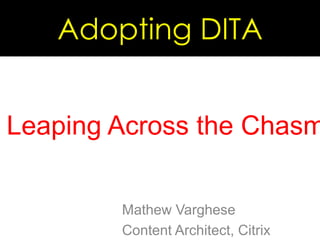
Why DITA?
- 1. Adopting DITA Leaping Across the Chasm Mathew Varghese Content Architect, Citrix
- 2. Agenda Why DITA Basics of DITA architecture Content reuse with DITA Semantic tagging and topic-based writing
- 3. Why DITA It’s all about adoptability the chasm
- 4. Think Information not Content “Come at once. We have struck a berg.” Content Content is a symptom, not a solution! Knowledge
- 5. Can your product sell itself?
- 6. Knowledge Stack Interfaces People Product Portals Processes and Tools People Content Developers Subject Matter Experts
- 7. DITA Building Blocks Topics Concept Task Reference Maps Ditamap Bookmap
- 8. Core Reuse Features (1.1) Ditamap Ditaval Conref
- 9. Ditamap Topic-level reuse C C R T R T C T T T T
- 10. DITAVAL Topic-level reuse Attribute Element Content
- 11. Conref Element-level reuse Conref Element Topic and location Element ID Topic ID
- 12. Reuse Scenarios Across releases Across deliverables Guides Formats Across audiences Across functions
- 13. Semantic Tagging and Topic-based Writing Get the specs Develop your tagging scheme Strengthen your analysis and design process Tagging and editing
- 14. Get the Right Specs Language Specification http://docs.oasis-open.org/dita/v1.1/langspec/ditaref-type.html Architecture Specification http://docs.oasis-open.org/dita/v1.1/archspec/archspec.html
- 15. Semantic Tagging Build your tagging scheme
- 16. Analysis and Design Design Walkthroughs Topic Audits
- 17. Tagging and Editing Editors are your greatest assets!
- 18. QUestions
Notas do Editor
- All the knowledge that the user needs to adopt the product should provided as efficiently as possible.
- We want to harness the knowledge that people within the organization possess. Content doesn't’t isn't a true representation of our products.It’s time to pull the experts.Documentation lacks depth – shows that somethings wrong in the knowledge sharing area.Creating lots of content is not the solution, We need to find a smarter way of pleasing the customer.
- This diagram illustrates the components of a knowledge ecosystem. The size of each component indicates the relative impact each component has on the efficiency of the ecosystem.